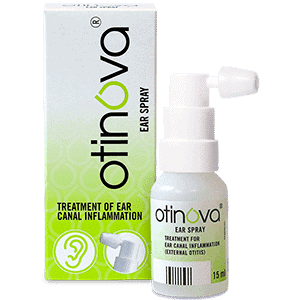FAQ
Read answers to the most frequently asked questions about Otinova® Ear Spray.
Common Ear Issues When on Holiday
Keep an eye out for these common ear issues so you can focus on creating those happy holiday memories.
Swimmer’s Ear (Otitis Externa) Swimmer’s Ear (or Otitis Externa) is the term for outer ear infection, and is often caused by trapped water when swimming or showering. The moist environment aids the growth of pathogens (fungi and bacteria) leading to redness, pain, swelling, inflammation, secretions or drainage (oozing) itchiness and possible muffled hearing. You can help prevent Swimmer’s Ear by wearing ear plugs and drying your ears well after swimming. However, if you do end up having symptoms you can relieve them by using Otinova®.
Airplane Ear (Barotitis) Airplane ear, also known as barotitis or aerotitis, is brought on when there is a sudden change in atmospheric air pressure. This happens when an airplane ascends quickly, and can also happen when diving in deep waters. If barotitis is a common occurrence when flying, you may be at risk of causing long-term damage to your ears (or ‘barotruama’). To help with mild barotitis when flying, you can suck on a sweet or yawn. If symptoms don’t improve, we recommend using ear equalisation device Otovent to open up the eustachian tubes to relieve ear pressure. Otovent can also be used as a visual aid to learn how to properly equalise your ear pressure for diving and prevent injury.
Itchy, Irritated Ears Itchy, irritated ears can stem from the use of in-ear devices such as earbuds, as well as from a change in climates or environment, or trapped water from showering or swimming. Reducing the amount of time you use in-ear devices can help alleviate this. If this doesn’t help, you may have trapped water or an injured lining of your ear canal causing inflammation or an outer ear infection, in which case Otinova® ear spray can help relieve symptoms.
Glue Ear Most commonly found in children who have small eustachian tubes, glue ear is when the middle ear retains sticky fluid (glue) due to an imbalance in ear pressure, effecting children’s ability to hear clearly. Symptoms of glue ear can worsen during flying because of the changes in air pressure, causing the fluid (glue) in the middle ear to expand which can lead to further discomfort. You can try using Otovent to help equalise the pressure in the middle ear, relieving discomfort and hopefully bad memories and associations for children when flying.
Disclaimer: *This article is for informational purposes only, and should not be treated as a substitute for medical advice, diagnosis or treatment.
Relieve Swimmer's ear
Relieve Itchy, Irritated Ears
Relieve Airplane Ear Pressure
Relieve Glue Ear in Children
How long can you use Otinova for?
Can you use Otinova® during pregnancy and when breast-feeding?
How long does a bottle of Otinova® last?
Why does Otinova® smell?
How do you treat a suspected ear canal inflammation?
How fast do the symptoms subside when treating with Otinova?
Why does the ear canal sometimes feel “crunchy” when having used Otinova?
How does Otinova® differ from other ear products, for example, prescription antibiotic/steroid drops, acetic acid solution and alsol solution/alsol-alcohol?
What is Burow’s solution?
References
- Jinnouchi O et al. Antimicrobial and therapeutic effects of modified Burow’s solution on refractory otorrhea. Auris Nasus Larynx. 2012;39:374-377.
- Kashiwamura M et al. The efficacy of Burow’s solution as an ear preparation for the treatment of chronic ear infections. Otol Neurotol. 2004;25:9-13.
- Hyo Y et al. Antimicrobial effects of Burow’s solution on Staphylococcus aureus and Pseudomonas aeruginosa. Med Mol Morphol. 2012;45:66-71.
- Clayton MI et al. A double-blind, randomized, prospective trial of a topical antiseptic versus a topical antibiotic in the treatment of otorrhoea. Clin Otolaryngol Allied Sci 1990, 15, 7-10.
- Lambert IJ et al. A comparison of the treatment of otitis externa with “Otosporin” and aluminium acetate: a report from a services practice in Cyprus. J Royal Coll General Pract 1981; 31: 291-294.
- Engström et al. Erfarenheter av Burows lösning i sprayform vid extern otit, Svensk ÖNH-tidskrift nr.3 2014.
- Örnhagen et al. External otitis – Burow’s solution returns to favour, Allmänmedicin nr.2 2013.
- Rosenfeld et al. Clinical Practice Guideline US: Acute Otitis Externa. American Academy of Otolaryngology – Head and Neck Surgery Foundation 2014, vol.150 (IS) S1-S24.
If you have any other questions that are not covered here please feel free to contact us.


